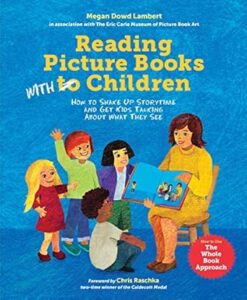
What picture book could be enjoyed by all ages?
I love a good picture book discussion with little kids, big kids, and grandkids! Megan Dowd Lambert, in her book Reading Picture Books with Children: How to Shake up Storytime and Get Kids Talking About What They See, explains The Whole Book Approach to reading picture books with children through examples, tips, and stories of her own journey. It’s a phenomenal resource for parents, teachers, tutors, speech therapists, artists, and librarians that will turn your storytime into a picture book playground.
I happened upon this book while browsing the “new book” section at the library. Surprisingly it is not a new publication, but I have been delighted with the find and immediately added it to my educational resource list for my tutoring business. I also knew I would write about it in my newsletter. It’s fine to read a book cover to cover and enjoy the story, but it’s a much richer experience to read and discuss the text, the art, and the book layout.

Along with teaching the reader about all the parts of a book, from the jackets to gutters to endpapers, Lambert addresses the importance and steadfastness of picture books amid today’s digital environment. It is exciting to see a child pick up a picture book you have read together and begin exploring it again on their own, adding to their knowledge by making new discoveries.
“By slowing down the reading to accommodate and encourage discussion about paratexts, design and production elements, and illustration, the Whole Book Approach swings wide the gates to the picture book as a playground for the mind, affirming that the child’s voice is crucial to the success of a dynamic, and yes, playful storytime experience.” Megan Dowd Lambert

Here are three tips for reading picture books with children to try out while you wait for your copy of the book to arrive. Yes, it’s that good. Order your book today!
- Compare and contrast the shape of the book to the content of the story. Try it with Madeline or The Very Hungry Caterpillar. Guide the discussion but do not direct it. See what the children come up with.
- Slow down and look at the pictures on the cover and the front matter. What might they tell us about the story? Try it with The Very Hungry Caterpillar.
- Choose any picture and ask questions. “What is going on in this picture? What do you see that makes you say that? What more can we find?” Use open-ended questions and give children space to agree and disagree. Try using these questions with Millions of Cats.
In the bonus section, this book gives a helpful overview of storytime with the Whole Book Approach including sample questions and resources. Read the book. Get together with another tutor or parent and have a book discussion about this book AND your favorite picture book.
I highly recommend this book Reading Picture Books with Children: How to Shake up Storytime and Get Kids Talking About What They See. Try out the Whole Book Approach. Try it out at the dinner table. Try it with preschoolers. Try it with older kids and a well-loved childhood picture book. Try it with grandma in the nursing home. Try it in a tutoring session or storytime with the grandkids.
Want some of my picture book suggestions? I think I love the art as much as the stories! https://www.tailorjoy.com/10-read-aloud-books-for-the-younger-years/
Table Talk: What is the first picture book that comes to mind when you think about the artwork? What picture book could be enjoyed and discussed by all ages? When is gutter talk appropriate when reading picture books?
Like this post? Share it with a friend!
2 minutes together books education parenting reviews tailor joy tutoring
